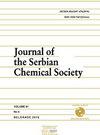Health risk assessment of potentially harmful substances from fly ashes generated by coal and coal waste combustion
IF 1
4区 化学
Q4 CHEMISTRY, MULTIDISCIPLINARY
引用次数: 0
Abstract
Lignite and coal waste used as feed fuels in thermal power plants (TPPs) and semi-industrial fluidized bed boiler (FBB), as well as their representative fly ashes (FAs), were examined. Fly ashes were compared employing anions and cations content in correspondent water extracts, trace elements and polycyclic aromatic hydrocarbon concentrations, as well as health risk assessments of substances known to be of concern for public health. Fluoride and sulfate contents in water extracted FAs are far below the legislation limits for waste, classifying all investigated FAs as non-hazardous. Among investigated trace elements, Cd content is the lowest, while Mn content is the highest. The highest enrichment ratios are noticed for As, Pb, Hg, Cu, V and Cr. The results indicate that total PAHs content is elevated in FA from the combustion of coal waste (AFB), with fluoranthene prevailing. The cancer risk of As and the non-cancer risk of As and Ni in some FAs surpass their respective permissible limits. The incremental lifetime cancer risk of an adult population indicates a potential PAHs risk in AFB, whereas all other fly ashes are within safe limits.煤炭和煤矸石燃烧产生的飞灰中潜在有害物质的健康风险评估
对火力发电厂(TPPs)和半工业流化床锅炉(FBB)中作为原料燃料的褐煤和煤矸石及其代表的粉煤灰(FAs)进行了研究。利用相应水提取物中的阴离子和阳离子含量、微量元素和多环芳烃浓度对粉煤灰进行了比较,并对已知对公众健康有影响的物质进行了健康风险评估。水提取的FAs中氟化物和硫酸盐的含量远远低于废物的立法限制,将所有调查的FAs归类为无害。在所研究的微量元素中,Cd含量最低,Mn含量最高。As、Pb、Hg、Cu、V和Cr的富集率最高。结果表明,煤矸石燃烧后的FA中总PAHs含量升高,以氟蒽为主。在一些FAs中,As和Ni的致癌风险和非致癌风险超过了各自的允许限度。成年人群终生癌症风险的增加表明AFB中存在潜在的多环芳烃风险,而所有其他飞灰都在安全范围内。
本文章由计算机程序翻译,如有差异,请以英文原文为准。
求助全文
约1分钟内获得全文
求助全文
来源期刊
CiteScore
1.80
自引率
0.00%
发文量
76
审稿时长
1 months
期刊介绍:
The Journal of the Serbian Chemical Society -JSCS (formerly Glasnik Hemijskog društva Beograd) publishes articles original papers that have not been published previously, from the fields of fundamental and applied chemistry:
Theoretical Chemistry, Organic Chemistry, Biochemistry and Biotechnology, Food Chemistry, Technology and Engineering, Inorganic Chemistry, Polymers, Analytical Chemistry, Physical Chemistry, Spectroscopy, Electrochemistry, Thermodynamics, Chemical Engineering, Textile Engineering, Materials, Ceramics, Metallurgy, Geochemistry, Environmental Chemistry, History of and Education in Chemistry.

 求助内容:
求助内容: 应助结果提醒方式:
应助结果提醒方式:


